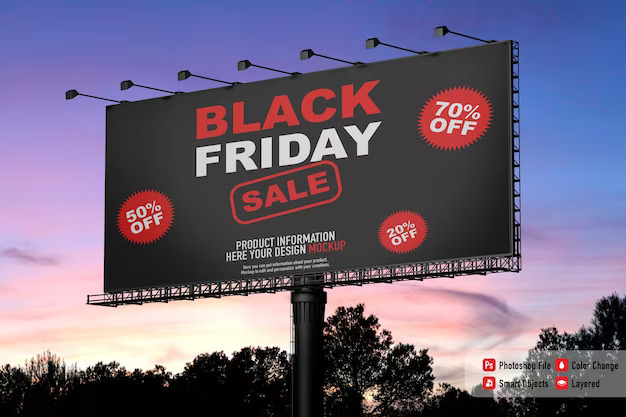Billboards are common on the roadsides, showcasing a variety types of products and services.
But have you ever stopped to think about the colors used on these billboards and their impact on you?
The world of advertising is heavily influenced by color psychology, which is the study of how colors affect
human emotions and behaviors. Let’s find the right colors for your billboard to make a lasting impression.
Understanding Color Psychology
First of all, color psychology is all about understanding how different colors can evoke specific emotions,
thoughts, and actions in people. It's an essential tool in the world of marketing and advertising,
as choosing the right colors can greatly influence how your message is received.
Colors & Their Roles On Billboard
By knowing the colors and how they represent the message, people can build great and attention-grabbing designs for the billboards.
Here are some colors and the emotions they represent:
Red is known for its ability to grab attention. It represents passion, excitement, and urgency.
Blue represents trust, calm, and reliability. It's a common choice for businesses looking to establish credibility and a sense of security.
Green represents nature, growth, and health. Suitable for environmentally friendly products and services or anything related to wellness.
Yellow is known for optimism, energy, and warmth that can make people feel happy and positive.
Black represents sophistication, luxury, and authority. High-end brands often use it to convey a sense of elegance.
Orange is a color of enthusiasm, creativity, and excitement for promoting new and innovative products.
Colour Mistakes To Avoid In Advertising
Choosing those colors is good but sometimes, it could be a wrong choice.
It depends on the situation and the messages that you want to convey.
Avoid these types of mistakes while designing your billboards:
Mid-tone on mid-tone: If your design features two colors that aren't harmonizing perfectly, try converting them to grayscale. This may help identify whether the color tones are closely matched, which might make it harder to read
Light on light: When light or pale colors overlap, it can objects difficult to see. Avoid using colors like yellow and other pale colors on white backgrounds when creating designs for both print and the web.
Dark on dark: A black background and dark font can make it difficult to read, especially at night. It is better to avoid using text in red, deep blue, or purple on a black backdrop. Black backgrounds should generally be avoided since they can obscure any font color, including white.
Choosing The Perfect Colors For Your Billboard
Now that we understand the emotions associated with different colors and what are the things to avoid while creating a design,
let's talk about how to choose the right color for your billboard. These are all the aspects that people should take note of before making a decision:
Know your audience by considering their age, gender, and interests.
Your billboard should align with your brand's colors and identity
Consider the message you want to convey. Is it a sale, a promotion, or a public service announcement? Your color choice should match the message.
Ensure that your text and graphics stand out from the background.
Color psychology is a powerful tool in the world of advertising and can greatly impact the success of your billboard.
Understand the emotions and associations tied to different colors, and by aligning your choices with your audience and objectives,
you can create a billboard that grabs attention and conveys your message effectively.
So, next time you're planning a billboard campaign, consider the colors carefully to make the most of color psychology in your advertising strategy.
Source from: Sufiahtul Nisa. "Color Psychology: Choose The Right Colours For Your Billboard", *16/10/2023*, https://firstboard.com.my/en/blog/color-psychology-choose-the-right-colours-for-your-billboard
Billboards are common on the roadsides, showcasing a variety types of products and services.
But have you ever stopped to think about the colors used on these billboards and their impact on you?
The world of advertising is heavily influenced by color psychology, which is the study of how colors affect
human emotions and behaviors. Let’s find the right colors for your billboard to make a lasting impression.
Understanding Color Psychology
First of all, color psychology is all about understanding how different colors can evoke specific emotions,
thoughts, and actions in people. It's an essential tool in the world of marketing and advertising,
as choosing the right colors can greatly influence how your message is received.
Colors & Their Roles On Billboard
By knowing the colors and how they represent the message, people can build great and attention-grabbing designs for the billboards.
Here are some colors and the emotions they represent:
Red is known for its ability to grab attention. It represents passion, excitement, and urgency.
Blue represents trust, calm, and reliability. It's a common choice for businesses looking to establish credibility and a sense of security.
Green represents nature, growth, and health. Suitable for environmentally friendly products and services or anything related to wellness.
Yellow is known for optimism, energy, and warmth that can make people feel happy and positive.
Black represents sophistication, luxury, and authority. High-end brands often use it to convey a sense of elegance.
Orange is a color of enthusiasm, creativity, and excitement for promoting new and innovative products.
Colour Mistakes To Avoid In Advertising
Choosing those colors is good but sometimes, it could be a wrong choice.
It depends on the situation and the messages that you want to convey.
Avoid these types of mistakes while designing your billboards:
Mid-tone on mid-tone: If your design features two colors that aren't harmonizing perfectly, try converting them to grayscale. This may help identify whether the color tones are closely matched, which might make it harder to read
Light on light: When light or pale colors overlap, it can objects difficult to see. Avoid using colors like yellow and other pale colors on white backgrounds when creating designs for both print and the web.
Dark on dark: A black background and dark font can make it difficult to read, especially at night. It is better to avoid using text in red, deep blue, or purple on a black backdrop. Black backgrounds should generally be avoided since they can obscure any font color, including white.
Choosing The Perfect Colors For Your Billboard
Now that we understand the emotions associated with different colors and what are the things to avoid while creating a design,
let's talk about how to choose the right color for your billboard. These are all the aspects that people should take note of before making a decision:
Know your audience by considering their age, gender, and interests.
Your billboard should align with your brand's colors and identity
Consider the message you want to convey. Is it a sale, a promotion, or a public service announcement? Your color choice should match the message.
Ensure that your text and graphics stand out from the background.
Color psychology is a powerful tool in the world of advertising and can greatly impact the success of your billboard.
Understand the emotions and associations tied to different colors, and by aligning your choices with your audience and objectives,
you can create a billboard that grabs attention and conveys your message effectively.
So, next time you're planning a billboard campaign, consider the colors carefully to make the most of color psychology in your advertising strategy.
Source from: Sufiahtul Nisa. "Color Psychology: Choose The Right Colours For Your Billboard", *16/10/2023*, https://firstboard.com.my/en/blog/color-psychology-choose-the-right-colours-for-your-billboard


